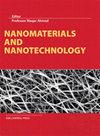Raphanus sativus L、Beta vulgaris L和basilicum叶片提取物合成纳米银及其在种子消毒中的应用
IF 3.3
3区 材料科学
Q2 MATERIALS SCIENCE, MULTIDISCIPLINARY
引用次数: 0
摘要
以Raphanus sativus (RsAgNPs)、Beta vulgaris (BvAgNPs)和Ocimum basilicum (ObAgNPs)叶片提取物为还原剂,采用绿色合成方法制备了纳米银颗粒(AgNPs)。植物化学成分分析表明,它们含有以类黄酮形式参与合成反应的酚类化合物。在紫外可见分光光度法中,合成的AgNPs在430 nm (RsAgNP)、440 nm (BvAgNP)和420 nm (ObAgNP)处出现最大吸收峰。扫描电镜和能量色散x射线能谱分析表明,RsAgNPs为76 nm直径的球,银含量高达54.1%;BvAgNPs为78 nm直径的球,银含量为39.76%;ObAgNPs为99 nm边缘的立方体,银含量为69.74%。发现的Z电位值表明所有得到的AgNPs在磷酸盐缓冲液中是稳定的。拟南芥(Arabidopsis thaliana)和番石榴(Psidium guajava)种子离体培养消毒率分别达到100%和90%,所有AgNPs均合成。这些AgNPs处理对番石榴种子的发芽率没有负面影响,相反,番石榴种子暴露于RsAgNPs后的发芽率更高。只有高浓度(10 mg/mL) agnp对拟南芥生长有抑制作用,而低浓度(0.01 mg/mL) ObAgNP和BvAgNPs对拟南芥生长有促进作用,分别比对照高60%和40%。所有AgNPs对大肠杆菌和氧化克雷伯菌均有抗菌活性,对用于植物遗传转化的农杆菌也有抗菌活性。本文章由计算机程序翻译,如有差异,请以英文原文为准。
Silver Nanoparticles Synthesized with Extracts of Leaves of Raphanus sativus L, Beta vulgaris L, and Ocimum basilicum and Its Application in Seed Disinfection
Silver nanoparticles (AgNPs) were produced by green synthesis using Raphanus sativus (RsAgNPs), Beta vulgaris (BvAgNPs), and Ocimum basilicum (ObAgNPs) leaf extracts as reducing agents. Plant phytochemical composition analysis indicated that they contain phenolic compounds that can participate in the synthesis reaction as flavonoids. Synthesized AgNPs presented maximal absorption peak at 430 nm (RsAgNP), 440 nm (BvAgNP), and 420 nm (ObAgNP) in ultraviolet-visible spectrophotometry analysis. Scanning electron microscopy and energy dispersive X-ray spectroscopy analysis showed that RsAgNPs are 76 nm diameter spheres made of up to 54.1% silver, the BvAgNPs are 78 nm diameter spheres with 39.76% silver, and the ObAgNPs are cubes of 99 nm edges with 69.74% silver. The found Z potential values indicate that all the obtained AgNPs are stable in phosphate buffer. A disinfection of 100% and 90% was achieved for the in vitro culture of Arabidopsis thaliana and Psidium guajava (guava) seeds, respectively, with all AgNPs synthesized. Treatment with these AgNPs showed no negative effects on germination, and on the contrary, in guava, a higher germination percentage was observed when the seeds were exposed to RsAgNPs. Only at high concentration (10 mg/mL) of AgNPs, the growth of A. thaliana was decreased, while at low concentration (0.01 mg/mL) of ObAgNP and BvAgNPs, higher growth was showed, specifically 60 and 40% more than the control, respectively. All AgNPs showed antimicrobial activity against Escherichia coli and Klebsiella oxytoca which are bacteria of clinical interest, and against Agrobacterium tumefaciens, a bacterium used in the genetic transformation of plants.
求助全文
通过发布文献求助,成功后即可免费获取论文全文。
去求助
来源期刊

Nanomaterials and Nanotechnology
NANOSCIENCE & NANOTECHNOLOGY-MATERIALS SCIENCE, MULTIDISCIPLINARY
CiteScore
7.20
自引率
21.60%
发文量
13
审稿时长
15 weeks
期刊介绍:
Nanomaterials and Nanotechnology is a JCR ranked, peer-reviewed open access journal addressed to a cross-disciplinary readership including scientists, researchers and professionals in both academia and industry with an interest in nanoscience and nanotechnology. The scope comprises (but is not limited to) the fundamental aspects and applications of nanoscience and nanotechnology
 求助内容:
求助内容: 应助结果提醒方式:
应助结果提醒方式:


